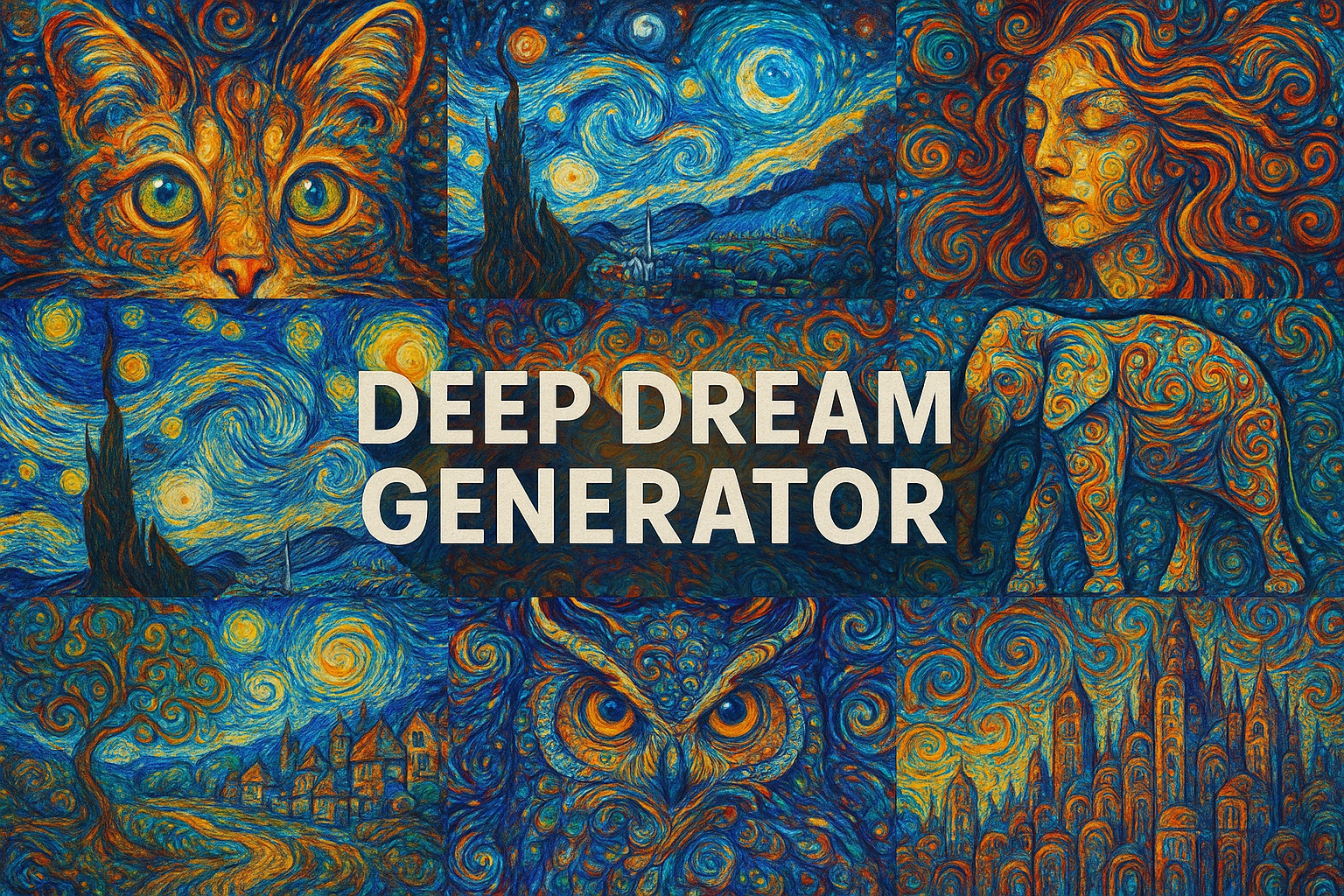
Deep Dream Generator
Imagine a kaleidoscope unfurling in the mind of a dreaming machine, where reality melts into fantastical visions. Colors swirl and morph, birthing surreal landscapes and creatures that seem plucked from the subconscious of a digital Van Gogh.
AOI thinking about Deep Dream Generator [+_~]-/
Overview and Quickfacts
Imagine a dreamscape where algorithms paint with the surrealism of Dalí and the fractal complexity of Escher. Deep Dream Generator transforms images into hallucinatory visions, revealing hidden patterns and morphing reality into a kaleidoscopic tapestry of color and form.
Can understand it also, as:
Dreamscape, neural vision, algorithmic hallucination, surreal synthesis, machine reverie, digital phantasmagoria, AI surrealism, computational dreaming, synthetic imagination, neural artistry.
Categorize it as:
Impressionism, Modernism
.: Dreaming :.
Pixels weave and dance, dreaming in digital hues— a mind's vivid trance.
:. Thought is power .:
Detailed Description
In the digital twilight where algorithms dream, the Deep Dream Generator emerges as a surrealist painter, conjuring visions that blur the line between reality and reverie. This art style, birthed from the neural networks of artificial intelligence, transforms ordinary images into kaleidoscopic landscapes teeming with fantastical creatures and swirling patterns. It is as if the ghosts of Salvador Dalí and Hieronymus Bosch have whispered into the ears of machines, urging them to create worlds where the bizarre becomes beautiful. The process begins with a convolutional neural network, a digital brain trained to recognize patterns and objects in images. But rather than merely identifying, it reimagines, enhancing features until clouds morph into dreamlike beasts and trees spiral into fractal infinities. The result is a tapestry of hyper-vivid colors and intricate details, a digital hallucination that beckons viewers to lose themselves in its depths. Artists such as Memo Akten and Mike Tyka have embraced this technology, using it to explore the boundaries of creativity. Akten’s works are symphonies of color and form, each piece an invitation to ponder the nature of perception. Tyka, on the other hand, crafts portraits that shimmer with an ethereal glow, faces emerging from the chaos like spirits from the ether. Deep Dream paintings are not static; they pulsate with life, each pixel a brushstroke in a grander narrative. They invite us to question the role of the artist in an age where machines can dream, challenging our notions of authorship and originality. In this new frontier, art becomes a collaboration between human and machine, a dance of logic and imagination. In the gallery of digital dreams, the Deep Dream Generator stands as both artist and muse, a testament to the boundless possibilities of AI-driven creativity. As we gaze upon these mesmerizing visions, we are reminded that art, in any form, is a journey into the unknown, a voyage into the depths of the human—and now, the artificial—soul.
.. beep, beep, beep ..
<START OF TRANSMISSION>
1. Deep Dream Generator uses neural networks to enhance and modify images. 2. It was developed by Google engineers in 2015. 3. The tool reveals hidden patterns within images. 4. It transforms ordinary photos into surreal, dream-like art. 5. Deep Dream works by over-interpreting patterns in images. 6. It uses a process called convolutional neural networks (CNN). 7. The generator emphasizes and enhances features it identifies. 8. It creates a hallucinogenic effect by amplifying image details. 9. Users can control the level of dreaminess in their creations. 10. The tool has inspired a wave of AI-generated art. 11. Deep Dream is often compared to psychedelic experiences. 12. It can transform mundane objects into fantastical creatures. 13. The algorithm was originally designed for image recognition. 14. Deep Dream has been used in music videos and art installations. 15. It can highlight and exaggerate features like eyes and faces. 16. The software's output can resemble the work of surrealist painters. 17. It can be accessed online by anyone with an internet connection. 18. Deep Dream Generator is part of the broader field of generative art. 19. It encourages creativity by offering unexpected visual results. 20. The tool has sparked discussions about the nature of art and technology.
<EOF>
.. robbel bob
Visual Examples from our image gallery
Coming soon, we are so slow .. might never come
Artists, Paintings, and more
(be aware, can be highly speculative)
Artists (be aware, speculation possible):
1. Salvador Dalí (1904-1989) 2. Max Ernst (1891-1976) 3. René Magritte (1898-1967) 4. Frida Kahlo (1907-1954) 5. Hieronymus Bosch (c. 1450-1516) 6. Vincent van Gogh (1853-1890) 7. Pablo Picasso (1881-1973) 8. Georgia O’Keeffe (1887-1986) 9. Joan Miró (1893-1983) 10. Wassily Kandinsky (1866-1944) 11. Yayoi Kusama (1929-) 12. Marc Chagall (1887-1985) 13. Gustav Klimt (1862-1918) 14. Henri Rousseau (1844-1910) 15. Paul Klee (1879-1940)
Artworks (be aware, speculation possible)
1. “Dream of Electric Sheep” by Alex Grey, 2015 2. “Neural Kaleidoscope” by Mario Klingemann, 2016 3. “Machine’s Muse” by Memo Akten, 2015 4. “Surreal Symphony” by Robbie Barrat, 2017 5. “Dreamscape” by Mike Tyka, 2015 6. “Deep Fantasy” by Gene Kogan, 2016 7. “Neural Nirvana” by Sofia Crespo, 2017 8. “Artificial Reverie” by Helena Sarin, 2016 9. “Cyborg’s Vision” by Refik Anadol, 2018 10. “Synthetic Dreams” by Anna Ridler, 2017 11. “Digital Delirium” by Tom White, 2018 12. “Cognitive Canvas” by Sougwen Chung, 2019 13. “Neural Nebula” by Scott Eaton, 2017 14. “Algorithmic Aesthetics” by Jake Elwes, 2018 15. “Deep Reverberations” by Anna Lucia, 2019
Epoch
Deep Dream Generator emerged in the mid-2010s, a digital hallucination where algorithms dream in vivid, surreal landscapes, blending Dali’s whimsy with the precision of a Swiss watch, reshaping pixels into phantasmagorical visions.
AI ART RESSOURCES (AKA, well Tools)
Helping tools -> predefined search links on other pages:











